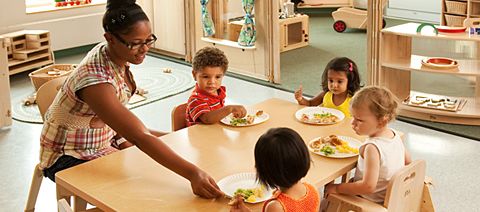Instilling Healthy Eating Habits in Young Children
| August 2012It is not always easy to get children to eat healthy foods. Despite the challenges, we all persist. Why is nutrition so important for young children? Providing children with nutritious foods is important to support their health, growth and development, while poor nutrition contributes to unhealthy weights in both children and adults. Because children's dietary habits are largely formed before the age of five, it is so important to support the development of healthy eating habits early. Clearly, early childhood is the ideal time to inspire healthy eating habits.
Food Neophobia
Actually, there are reasons why it is so difficult to encourage children to eat the right foods. Young children have innate "food neophobia" – literally a fear of new foods. As adults, we know that the broccoli on their plate will not poison or even worse kill them – but subconsciously, children actually think it might. How can this be? This fear of new food stems back to paleolithic/pre-agriculture times. By around the age of three, children had developed enough dexterity to become part of the "gathering" workforce of the hunting and gathering societies they lived in. One of the greatest concerns among these early societies was that they might forage something that would literally poison or kill them. Therefore, even when they were extremely hungry, they would avoid eating an unknown plant. This inborn fear is especially pronounced around bitter-tasting foods. The general rule of thumb was that if something tasted sweet it was probably safe to eat, but bitter foods were far more likely to be poisonous. The naturally bitter taste of many vegetables helps explain why it is easier to convince a child to eat fruits than vegetables.
How do we assist children in overcoming food neophobia? The goal is to support children in becoming more comfortable with these new foods. Providing non-threatening, non-coercive multiple exposures to a new food helps change a child's reaction from rejection to acceptance. Research suggests that it takes 8-12 exposures to a new food for most children to alter their reaction. For some children it may take up to 50 exposures. Simply serving the food or making it available again and again starts to break down food neophobia. Guiding a child in exploring a new food using all of his senses or engaging a child in growing and/or cooking with a new food helps them develop a relationship and a comfort level with that food. This can be done at school or home and ideally occurs simultaneously in both settings.
What Message Are We Sending?
But food neophobia is not the only challenge. Children between the ages of three and five become increasingly aware of the social and environmental messages around food. If we are not careful, young children will be bombarded with messages promoting unhealthy foods. Did you know, for example, that a TV in a child's bedroom is associated with childhood obesity because of the aggressive food marketing it exposes them to? As technology mushrooms, marketers have unprecedented access to children. Yet, while TV commercials and food advertising play a big role, corporations are not the only ones at fault. Many of the messages to eat unhealthy foods occur in childcare and home settings. For instance, exciting events are often associated with less healthy foods. Take a moment to think about the foods typically served at birthday parties, holidays, movies and baseball games. In our culture, we routinely couple the foods we do not want children to eat with very positive social messages and environments. Now think about messages young children receive about healthy foods – having to finish their broccoli (punishment food) in order to get dessert (reward food) or hearing a parent openly complain about having to eat "green foods." Of course, serving raw asparagus spears at a party is not all it takes. But we can start serving nutritious foods in positive social settings to help children develop positive associations with the foods we want them to choose more often. In childcare centers this can occur on a daily basis by making only healthy food choices available during meal and snack times and keeping the environment positive. We can extend this positive environment into the homes of children by helping families understand that the energy spent supporting children in eating the right foods should be directed toward deciding which foods should be brought into the home, rather than ultimatums at the dinner table. In fact, research shows that using food as a reward or punishment actually decreases a child's preference for those foods. Ultimately, caregivers and parents should decide which foods are available to children and children should decide if and how much of those foods they will consume. When only healthy foods are available, both children and adults easily make nutritious choices.
Positive Role Models
We all know that caregivers and families serve as powerful role models for young children. Think about how often young children imitate the behavior of the significant adults in their lives. Positive role modeling around food is crucial to supporting young children in eating well. If adults are openly enthusiastic about making nutritious choices and trying new and different foods, children will follow suit. The diets of young children closely resemble those of primary adults in their lives. Adults who exhibit negative attitudes around nutritious foods are even more powerful role models. Like most adults, children have a natural fondness for sweet, salty, calorie-dense foods. Children are quick to notice if their mother pushes green beans to the far side of her plate or if their father only eats salad when he is dieting. They notice the teacher who keeps her caffeinated beverage in a corner of the classroom, quickly grabbing a sip when she believes no one is watching. Establishing nutrition policies (such as eliminating outside foods or having adults and children consume the same foods) in your child care center is crucial to supporting young children in making good food choices.
Finally, be mindful in the language used around food with children. An effective response to a child who tastes a new food and says "yuck" is "you don't like it yet?" This response lets the child know that you heard and understand that he does not like the food he just tasted, but also clearly communicates to the child that he may like it in the future. Child care centers and homes that routinely use this phrase find that it is quickly adopted by the children. For example, three-year old Grady tasted a red pepper several times during the school year. When sharing this experience with his mother he said, "At first I did not like it yet. Then I liked it a little. And now I like it a lot."
In Conclusion
As caregivers of young children, you are in a unique position to encourage them to establish good dietary habits, and help them to avoid the food-based challenges so prevalent in our society today. By patiently providing a child with multiple opportunities to experience and taste new foods, by creating positive social messages and environments around nutritious foods, and by being mindful of the impression you are making on young children with both your actions and words – you can help create a nutritionally purposeful environment in which young children will flourish.
Comments
Thank you for your informative article regarding Obesity, and what we educators can do to stem the tide. I'd like to suggest the following, introducing children to the benefits eating healthy foods:
- Have children plant their own personal garden in the classroom consisting of finger foods such as carrots, cucumbers, yellow & orange sweet peppers and celery.
- Once vegetable have ripened, have children pick them.
- Teachers can then wash vegetables, remove skin from cucumbers and slice each into bite-size portions.
- Place each vegetable in a covered contain with a picture of its contents on its top, provide napkins, and small containers of honey mustard for dipping. Then place around the classroom in various areas.
- Allow children to snack at will as they play. I sincerely believe when children take pride in something they've created, it becomes more meaningful; sparking the curiosity to indulge. (You can also buy everything ready-made) Bon Appetite!
Kimberly Railey, M.Ed.







